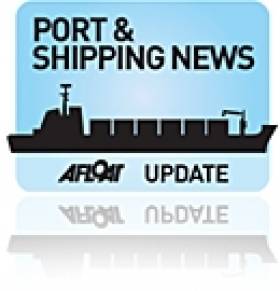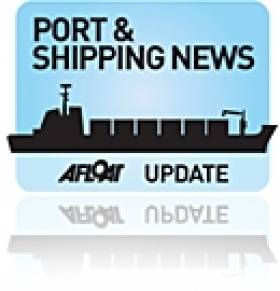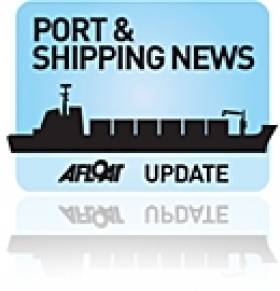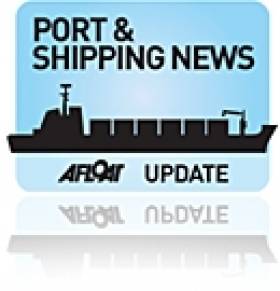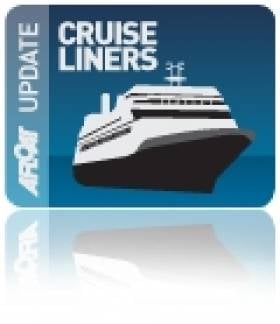Displaying items by tag: Clipper Adventurer
Missing 'Ghost Ship' May Have Sunk In Atlantic
#GhostShip - The Irish Coast Guard is on alert after indications that the missing 'ghost ship' MV Lyubov Orlova may have sunk in the Atlantic as it drifted towards Ireland's coast.
RTÉ News reports that an emergency transponder signal on the vessel that only activates on contact with water was picked up by coastguard monitors last week.
No sign of the ship was detected in satellite images of the area some 1,700km west of Valentia where the signal originated, leading to speculation that the ship has sunk.
But the possibility that the signal device was washed overboard cannot be ruled out.
As previously reported on Afloat.ie, the MV Lyubov Orlova was being transported from Canada to the Caribbean for scrapping in late January when it broke free of its tow-line and went adrift in the Atlantic in the general direction of Europe.
With no lights and its Automatic Identification System (AIS) switched off, it could not be located by conventional means - leading the Irish Coast Guard to collaborate with marine surveillance expert Guy Thomas on his new Global Maritime Awareness system in the hopes of detecting the vessel as it approached Irish waters.
The MV Lyubov Orlova is the sister ship of the polar cruiser Clipper Adventurer, the first ever cruise liner to visit Drogheda Port when it entered the mouth of the Boyne last summer.
Drifting ‘Ghost' Ship’s Sister Made Historic Call to Drogheda
#GhostShip – As previously reported on Afloat.ie, the 'ghost' ship Lyubov Orlova, which broke its tow-line in the Atlantic more than three weeks ago is a sister of the first cruiseship caller to Drogheda Port, writes Jehan Ashmore.
The small cruiseship, Lyubov Orlova of 4,251 tons was built in Croatia a year before Clipper Adventurer, which made a historic call to the port on the Boyne last year. Clipper Adventurer, which was at one stage the Alla Tarasova and Lyubov Orlova belong to a series of eight sisters built for the Murmansk Shipping Company.
As ice-strenghtened vessels, they are designed to withstand heavy seas while operating as expedition ships, carrying passengers to both the Arctic and the Antarctic.
According to Travel.aol.co.uk, the drifting vessel is some 1,200 (nautical miles) off Galway.
A report in Canadian news service The National Post says that the Irish Coast Guard is examining satellite imagery to ensure the ship can be retrieved before it breaks apart or drifts into shipping lanes.
Responsibility for the vessel has already been disavowed by the Canadian authorities after the vessel, which was being towed from Canada to the Dominican Republic for scrapping, broke loose from its cabling.
Drogheda Port Handled 1m Tonnes in 2012
#DroghedaPort – Over 1m tonnes of cargo was handled in 2012 by the Drogheda Port Company.
According to the Co. Louth port, this level of cargo outperformed the Irish port sector in terms of year on year throughput growth.
Throughputs increased by 95% on last years volumes and it is the first time since 2007 that the port handled over one million tonnes of cargo.
The latest national volumes indicate that the volume of port and shipping traffic through the Republic of Ireland showed little growth in the third quarter of 2012 according to the figures released by the Irish Maritime Development Office (IMDO).
The latest analysis of national traffic data indicates that two of the five principal freight segments returned to growth in the third quarter, two declined and one remained unchanged.
Against this backdrop Drogheda Port's volume growth is particularly impressive. Export volumes performed well with minerals, construction bulks and agri-trades all increasing.
The company is continuing to provide a competitive operational base to its many customers and attract new business with increased flexibility and facilities.
Nationally the outlook for the sector in 2013 remains challenging as continued uncertainty in the European and wider Global Economy continues to weaken market demand and impact on consumer confidence.
Commenting on the ports performance CEO Mr Paul Fleming said "The company is pleased to report that trade volumes increased significantly in 2012 and we will continue to grow volumes in 2013 in specific market sectors. It is also noteworthy that the port is playing a central role in facilitating the national export lead recovery."
He also noted "The company continues to support the local tourist economy with the first ever cruise call (as previously reported on Afloat.ie of the Clipper Adventurer) in 2012. A number of new maritime tourism initiatives will be announced in 2013 to support and stimulate the local economy."
#PORTS & SHIPPING REVIEW – Dublin 'Docklands' floating river-restaurant ship M.V. Cill Airne celebrated her 50th anniversary having been built nearby at the Liffey Dockyard. A special lunch and lecture organised by the Cobh branch of the World Ship Society was held on board the veteran vessel which represents one of the last surviving ships built in Ireland and which remains around our coast having had a rich and varied career.
Along the Shannon Estuary the mid-west port of Foynes welcomed the first cruise call for this year with the arrival of the 28,000 tonnes ultra-luxury Silver Whisper. Passengers from the 382 capacity cruiseship toured the region including the local Foynes Flying Boat Museum.
Returning to the East coast where in Drogheda Port, onlookers welcomed the first ever scheduled cruise call to the Boyne when the Clipper Adventurer berthed at the Co. Louth port to complete a circumnavigation cruise of the island where US and Canadian passengers disembarked.
Down the coast the RV Keary was undergoing refit at Arklow Marine Services yard. The research vessels owners Geological Survey of Ireland (GSI) have chartered the Cosantoir Bradan from the Central Fisheries Board for survey work to assist the RV Keary.
In the capital the veteran grab-hopper dredger Hebble Sand (1963/757grt) departed Dublin Dry-Dock facility in readiness for a new career working with Northern Ireland based Abco Marine. The former Dundalk Port Company owned vessel which resembles the last of the Guinness ships, currently remains in the port awaiting her first delivery voyage for contract project work.
Across the Irish Sea the first of two new offshore patrol vessels (OPV) for the Naval Service had its keel-laid at a ceremony at Babcock Marine's shipyard in Bideford, north Devon. The €99m pair are an enlarged version of the 'Roisin' class L.E. Roisin (P51) and L.E. Niamh (P52) which were launched from the same UK yard over a decade ago then owned by Appledore Shipbuilders.
Historic First as Cruiseship Calls to Drogheda Port
#DROGHEDA CRUISE CALL – The first ever cruiseship to visit Drogheda Port was welcomed this morning as Noble Caledonia' 122 passenger Clipper Adventurer (1975/ 4,367grt) entered the mouth of the Boyne, writes Jehan Ashmore.
Onlookers came out to view the historic arrival of the 101m long vessel which normally cruises in polar waters, either Antarctica or the Arctic. She berthed at Tom Roe Terminal, downriver from the older town-centre quays, having set off from Cork earlier this month on a 10-day circumnavigation cruise of Ireland.
On board the ice-strengthened exhibition vessel were American and Canadian passengers who were on the cruise organised by Adventure Canada, in association with Royal Canadian Geographical Society. Prices for the cruise which featured a varied lecture programme started from $3,995 dollars.
Facilities include a main lounge, bar, clipper club, library/card room, gymnasium and gift shop and throughout the intimate vessel, she sports plenty of varnished wood, brass, and timber lined decks. The new outside cabins have lower beds and private facilities in addition each with window view.
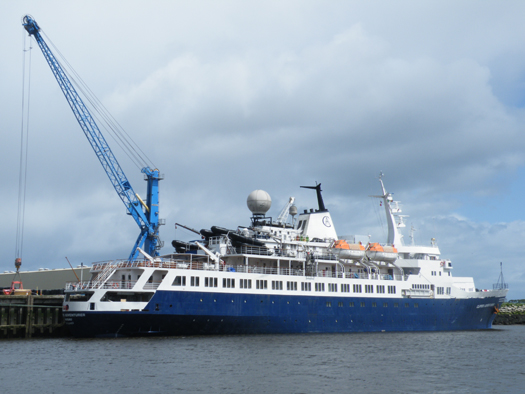
M.V. Clipper Adventurer moored alongside Tom Roes Terminal, Drogheda Port.
Photo: Jehan Ashmore
It is estimated the passenger spend generated from the cruise to the Boyne Valley is €60,000, the windfall will be a boost to the local economy. On foot of this the Drogheda Port Company has been in dialogue with a number of interested parties to build the brand and grow cruise business tourism in the region.
A small cruiseship such as Clipper Adventurer offers a more 'boutique' style of operation, in that she calls to more isolated destinations compared to the really large cruiseships. Among the ports of call on this Irish cruise they were to Kinsale, Dingle, Cliffs of Moher, Aran Islands, Westport and Tory Island.
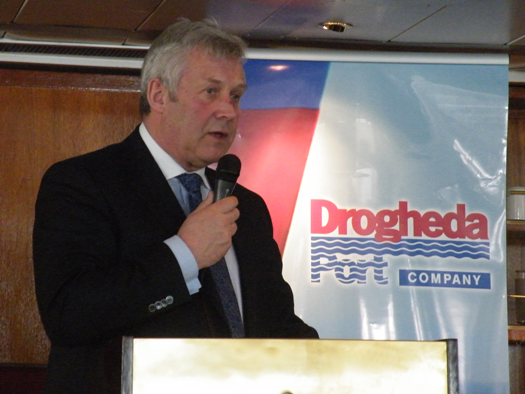
Minister of State Fergus O'Dowd speaking at a reception on board Clipper Adventurer to mark the historic cruise call visit
Where there are no port berthing facilities, passengers use instead a fleet of the vessels zodiacs which whisk them ashore to make excursions. Today her passengers disembarked to take a coach tour to the world famous visitor attractions along the Boyne Valley, before flying out of Dublin airport.
Not only is the cruise call a first for Drogheda Port but where a fly-cruise option is made available and also in reverse as the crew of the Clipper Adventurer are to welcome this evening more passengers flying in from Denmark. These passengers are to embark on a 6-day cruise of the Scottish Isles, terminating at Lerwick. The cruise is organised by Copenhagen based Albratros Tours.
Circumnavigation Cruise of Ireland Deferred as Bad Weather Delays Cruiseship from Argentina
#CRUISE LINERS – Due to bad weather a 11-day circumnavigation cruise of Ireland by Clipper Adventurer which is currently en-route from Argentina has been diverted to Cork, deferring the start of the cruise which was due to depart from Waterford today, writes Jehan Ashmore.
The 101m long vessel operated by Noble Caledonia was to welcome over 230 American and Canadian passenger on a cruise organised by Adventure Canada, in association with Royal Canadian Geographical Society.
According to the cruise itinerary the tourists were firstly to fly to Dublin and stay last night in a city-centre hotel. Also originally as scheduled was a coach tour today to visit Glendalough and the Rock of Cashel before reaching Waterford this afternoon to board the small expedition ship.
Despite the setback the 4,000 tonnes vessel with a crew of 65 which is on a repositioning voyage from South America to Europe was to make Cork her port of call tomorrow anyway. The only change being the embarkation port at the expense of the crystal city.
Clipper Adventurer is expected to arrive in Cork Harbour from 12 noon tomorrow and head for Ringaskiddy Deepwater Terminal. Also due is the 290m Emerald of the Seas which at 113,000 tonnes is in complete contrast as the massive vessel can accommodate over 3,500 passengers and 1,200 crew. She is to berth at Cobh cruise terminal.
Asides cruise callers the ferryport in Ringaskiddy will be as usual expecting the weekend-only call of Brittany Ferries flagship cruiseferry Pont-Aven, having made a crossing overnight from Roscoff.
While on the May Bank Holiday Monday Cobh is also set to welcome an even larger cruise caller in the form of the Independence of the Seas. The 154,000 tonnes giant is no stranger to the harbour as she made her maiden 'Irish' port of call in 2007. She can handle over 4,300 passengers and over 1,300 crew alone.
First Quarter Boost for Drogheda Port
#PORTS & SHIPPING – After the first three months of 2012 Drogheda Port Company reported figures well above average in the port sector with throughput growth posting an impressive 59% increase on the corresponding period of last year.
Over 228,000 tonnes of cargo was handled by the Co. Louth port and for the first time the balance of trade in the port equalised with 50% of the volume represented by imports and 50% of the volume represented by exports.
The volume growth at the port is very much export led with a number of indigenous industries focusing on the European and UK markets as outlets for their products.
As previously reported on Afloat.ie a new tonnage record was set in January when the Arklow Bridge (2011/4,723grt) carrying 7,175 tonnes of maize representing the largest ever single cargo handled in the port.
Mr Paul Fleming, Drogheda Port Chief Executive said "Drogheda Port continues to provide a strategic import/export location for our customers with a service more flexible and cost competitive than other larger ports. This is helping us to win new contracts and grow our business".
He added: "The ports performance demonstrates the economy is rebalancing towards exports at a time when our economic recovery is very much dependent on being driven by our exporting firms."
The outlook for the Irish port sector for 2012 looks likely to be testing for the domestic port and shipping sectors and according to the port they project to continue above average volume increases for the year.
In May the port can look forward to hosting its first cruise call by the Clipper Adventurer (1975/4,367grt) as previously reported. The vessel will be undertaking its inaugural circumnavigation of the island of Ireland visiting a number of destinations including Drogheda and the Boyne Valley.
Drogheda Port to Become New Cruiseship Destination
#CRUISE LINERS- In a first for Drogheda Port, the cruiseship, Clipper Adventurer (1975/4,367grt) is to call next May, and will represent a new business to the port as part of its circumnavigation of the island of Ireland, writes Jehan Ashmore.
The 101m long vessel will bring 236 American and Canadian visitors and a 65 crew, on a cruise organised by Adventure Canada, in association with Royal Canadian Geographical Society.
During the 10-day circumnavigation, the vessel will make calls to the Co. Louth port with passengers touring the Boyne Valley, The Skelligs, Aran Islands, the Gardens on Garnish at Glengariff and Tory Island. They will take in the history, archaeology, bird and marine life, culture, and Irish music in addition to a lecture programme from an on board team.
"With its downtown location, Drogheda Port is perfect for us," says Matthew Swan, president of Adventure Canada.
Last year, Swan visited Drogheda to conduct research for the cruise trip around Ireland. "I heard about your Graffiti and Samba Festivals before coming to town. It seemed like my kind of place, I'm definitely coming back for the Samba event."
Nessa Lally of Drogheda Port commented on the launch of the port as a new cruise destination: "Drogheda Port Company is pleased to announce the inaugural visit of the Clipper Adventurer to our port. This is the beginning of something special for Drogheda and the Boyne Valley.
The area has tremendous potential as a regular cruise destination with world class and potential world class attractions such as Newgrange, Slane Castle, Beaulieu House, the Battle of the Boyne site, the Hill of Tara and medieval Drogheda town itself, to mention just a few.
We will very much welcome the Clipper Adventurer and its passengers to our port and town and intend to give them a memorable visit to our locality. The port company has also commenced a dialogue with a number of interested parties to build and brand a full local itinerary for attracting and growing cruise business and tourism."
In the same month of the inaugural cruise, Drogheda will host a second cruise also by Clipper Adventurer, with Danish passengers organized through Copenhagen-based tour operator, Albatros Travel. They will undertake a 10-day Irish and Scottish itinerary that finishes in Bergen, Norway.
Clipper Adventurer is an exploration vessel which otherwise is often found cruising in polar waters, either Antarctica or the Arctic from Spitsbergen through Iceland, Greenland and Canada's Northwest Passage.
Over the last decade she has called to several Irish ports to include a once-off call to Arklow, where the Serbian-built vessel anchored offshore.


























